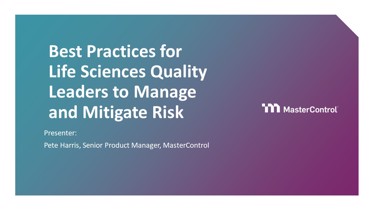Best Practices For Life Science Quality Leaders To Manage And Mitigate Risk

Every business has to manage risk, but in life sciences this is even more important. Proper risk management can literally save lives since these practices are used in the development of pharmaceuticals and medical devices. But risk management can still come down to manually completing a Failure Mode and Effect Analysis (FMEA), storing the paperwork in a filing cabinet, and never taking another look at it until an audit or inspection. Even if this technically fulfils the requirements for risk management, it doesn’t do much to actually manage risk.
Risk management should involve preventive or corrective mitigations to reduce the risk followed by a process to monitor and revisit those plans from time to time. Without follow up, nothing is actually being managed or mitigated. MasterControl’s digital risk management system can help with tracking and making necessary changes to ensure efficacy, and with the added benefit of advanced analytics and artificial intelligence (AI), risk management can be smarter and more automated.
Risk doesn’t exist in a vacuum. The more data a company can collect, the more accurate their risk assessment and risk mitigation plans will be. Pulling information from multiple systems lets users detect areas of high risk, monitor those automatically, and the use of AI can reveal the most effective risk mitigation plans.
Key takeaways from this session include:
- How to improve traditional risk management methods and tools
- How MasterControl helps quality professionals manage risk
- How AI can help in the identification and mitigation of risk
Get unlimited access to:
Enter your credentials below to log in. Not yet a member of Outsourced Pharma? Subscribe today.
